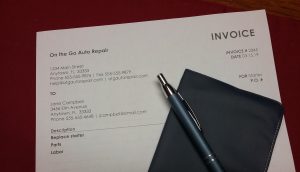
by Judy Corbus | Mar 22, 2019

Unexpected expenses? Be prepared with a “rainy day” fund. Photo credit: UF/IFAS Northwest District
It began as a normal six-month dental check-up – no pain, no problems. After the X-rays, cleaning, and exam, my dentist informed me the X-ray showed an abscess above a back molar. The next thing I knew, I was headed to the endodontist for a root canal then back to my dentist for a permanent filling – wow! Who saw that coming? That was a classic “Life happens” moment!
We all face those unexpected events – a flat tire, a faulty alternator, an appliance on the fritz, a medical emergency. The question is, do we have the funds available to cover it? An emergency, or “rainy day,” fund helps us to handle those surprise expenses more easily, reducing our need to borrow to pay for them.
How much should we have in our emergency fund? A minimum of $1000 is a good starting point – that typically will cover most emergencies. A fully funded emergency reserve is three to six months of expenses; some financial advisors recommend eight to 12 months of expenses. If you are the sole breadwinner in your household, funding it to six months or beyond gives you a greater cushion. What is significant about these numbers? If you were unable to work due to a job loss, layoff/furlough, illness, or a family emergency, you would have funds available to tide you over until you could get back on your feet. Having funds to keep you afloat for a few months removes a lot of pressure and may allow you to explore your options without feeling like you need to take the first job offer that comes along because you “need the money.”
How do you fund your emergency fund? Look at your finances and, if you aren’t already in the habit of doing so, set aside a portion of your paycheck for savings right off the top – pay yourself first! Even if it’s just a few dollars per paycheck, those dollars will add up. If you receive a pay raise, save the difference between the new amount and your pre-raise salary. Your income tax refund is another great way to jump start your emergency fund – use Form 8888 Allocation of Refund to direct deposit your refund into one or more accounts.
It is a fact of life that life happens – be prepared with an emergency fund!
For more information on saving for emergencies, please see UF/IFAS FCS 7014 Money and Marriage: Saving for Future Use.
by Kristin Jackson | Feb 28, 2014
Normal
0
false
false
false
EN-US
X-NONE
X-NONE
/* Style Definitions */
table.MsoNormalTable
{mso-style-name:”Table Normal”;
mso-tstyle-rowband-size:0;
mso-tstyle-colband-size:0;
mso-style-noshow:yes;
mso-style-priority:99;
mso-style-parent:””;
mso-padding-alt:0in 5.4pt 0in 5.4pt;
mso-para-margin-top:0in;
mso-para-margin-right:0in;
mso-para-margin-bottom:8.0pt;
mso-para-margin-left:0in;
line-height:107%;
mso-pagination:widow-orphan;
font-size:11.0pt;
font-family:”Calibri”,”sans-serif”;
mso-ascii-font-family:Calibri;
mso-ascii-theme-font:minor-latin;
mso-hansi-font-family:Calibri;
mso-hansi-theme-font:minor-latin;}
 Are you “liquid asset poor?” If a household experiences an unexpected financial strain, such as a job loss, illness, or other large expense, and does not have enough liquid assets to cover basic expenses for three months, they are considered liquid asset poor. Liquid assets consist of money held in checking or savings accounts. According to recent research conducted by the Corporation for Enterprise Development, approximately 49% of Floridians are considered liquid asset poor.
Are you “liquid asset poor?” If a household experiences an unexpected financial strain, such as a job loss, illness, or other large expense, and does not have enough liquid assets to cover basic expenses for three months, they are considered liquid asset poor. Liquid assets consist of money held in checking or savings accounts. According to recent research conducted by the Corporation for Enterprise Development, approximately 49% of Floridians are considered liquid asset poor.
Emergency funds focus on increasing liquid assets though savings. An emergency fund can allow households to adapt when unexpected financial strains occur. In the past, three to six months of income was considered to be a good emergency fund. In more recent times, the economy and unemployment have caused households to need much larger emergency funds. University of Florida professor, Dr. Michael Gutter, in “Money and Marriage: Saving for Future Use,” encourages families to consider the following factors:
- How much protection is provided by insurance
- Number of household incomes
- Household needs and fixed obligations
- Family financial support
- Retirement proximity
- Age of children
- Available credit
You can get an estimate of your household’s liquidity by completing the following steps:
1) Calculate the total amount of cash you have on hand and in your checking/savings accounts.
2) Develop a spending plan to allow you to estimate your monthly expenses.
(For help with developing a spending plan, check out Building a Spending Plan)
3) Enter your total cash and monthly expenses into the household liquidity formula:
Total Cash ÷ Monthly Expenses= Household Basic Liquidity
If the household basic liquidity is equal to or less than 1, this would be interpreted as having enough liquid resources to sustain your household’s current spending for only a month or less. If the household basic liquidity ratio is greater than one, that number is the number of months you would be able to live on your liquid assets based on your current spending. If you are not at your desired or expected number, take the pledge to start saving today at America Save$!
References:
Corporation for Enterprise Development. (2014). “Liquid Asset Poverty Rate”
Gutter, M. (2011). “Money and Marriage: Saving for Future Use”
Turner, J. (2001). “Show Me The Money: Lesson 5: Savings and Investments”



